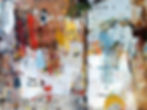Borderline of Abstraction | Andrew Hood
Andrew Hood’s work has long hovered on the border between representation and abstraction, allowing him to adeptly capture both the look and feel of the locations depicted in his paintings. However, more recently his paintings have nudged slightly more towards abstraction, with colour and movement taking centre stage.
We caught up with Andrew at his studio in Bristol to find out more about this development in his practice and to get a first look at the new paintings.
Photos courtesy of Alice Hendy.

Why are you focusing more on abstraction in your work at the moment?
Whilst my painting usually depicts a particular place or uses a fairly accessible composition I think that it’s often the colour, movement and more abstract elements that make it work, so I’m really just trying to push things in this direction a little. I’m naturally inclined to be representational so it’s not necessarily an easy process for me but it’s something that I like to experiment with. I like to see how far can I push the boundaries of representation without losing what drew me to a particular subject in the first place.
How does your process change when you’re working on more abstract paintings?
Typically when I start a painting it’s a very abstract process and then as I develop and refine it I start to add more recognisable aspects. Recently I’ve been trying to leave out these figurative elements and let the paint take its course. Sometimes both the viewer and the artist need representational points or markers to help understand a painting, however the use of colour and mark making can play an even greater role but in a more direct and emotional way.

Is it important to you that people can recognise the place depicted in the painting?
This sometimes seems to be more important to the viewer than to me. The places that I’ve travelled to and have a strong connection with provide the starting point for my work, but when the painting begins to take on a life of it’s own then that in itself becomes just as important, or perhaps even more important, than what I was trying to depict in the first place and I’m happy with that. The painting can work on a whole new level. I still love painting certain places such as Morocco, India and parts of Europe but I don’t see accuracy as an essential component to my work.


Which abstract artists inspire you?
I was really inspired by the Abstract Expressionism show at The Royal Academy a couple of years ago, and particularly the work of Joan Mitchell, Willem de Kooning and Franz Kline. You could feel that this was a group of artists in search of a new way of working and a new artistic language. Moving away from figurative painting was a very bold step and involved rejecting the accepted formulas of the time and looking for a new form of expression. To me, their paintings seemed to be more inspired by rhythm, movement and colour rather than representation.

Dawn, Sicily | 115x88cm | Oil
Would you say your new work is therefore very different to your usual style of painting?
I wouldn’t say that I have completely changed direction but I’m certainly allowing the more haphazard elements of my painting to dominate. My smaller studies that I use as reference for my larger pieces are definitely very abstract and I’m letting this lead me in a new direction. I would say I’m searching for some new territory to explore and to see how I can develop and expand my painting repertoire.

See more of Andrew's new paintings here, and if you'd like to make an enquiry about any of the works please don't hesitate to get in touch.
You can also sign up to our mailing list to receive occasional updates on Andrew's practice and upcoming art fairs.






















